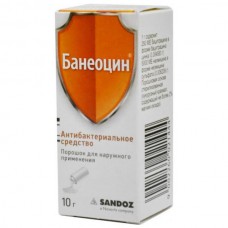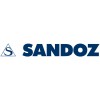Expiration date: 04/2025
Structure and Composition:
Ointment for external application
active substance (per 1g):
bacitracin (in the form of zinc bacitracin) 250 ME
neomycin (Neomycin sulphate form) 5000 ME
Excipients: lanolin, white soft paraffin
in tubes of 20 g of aluminum in the paper cartons 1 tube.
Powder for external application
active substance (per 1g):
bacitracin (in the form of zinc bacitracin) 250 ME
neomycin (Neomycin sulphate form) 5000 ME
Excipients: sterile powder base (maize starch containing no more than 2% magnesium oxide)
PE in 10 g jar with a plastic dispenser in paper cartons 1 bank.
Description pharmaceutical form:
Ointment for external application: yellowish, homogeneous, with a weak characteristic odor.
Powder for external use: fine, white to yellowish color.
Pharmacokinetics:
The active compounds are generally not absorbed (even broken skin), however, they are present in high concentrations skin.
Baneocin well tolerated. Tissue tolerance is regarded as excellent, inactivation of biological products, blood and tissue components are not marked. If the drug is applied to extensive areas of skin lesions, should take into account the possibility of absorption of the drug and its effects (see. Forums "Side effects", "Interaction," "Contra" and "Cautions").
Description of the pharmacological actions:
Baneocin is a combined antibacterial indicated for topical use.
Baneocin contains two bactericidal antibiotic neomycin and bacitracin.
Bacitracin is a polypeptide antibiotic which inhibits bacterial cell membranes.
Neomycin is an aminoglycoside antibiotic that inhibits protein synthesis bacteria.
Bacitracin is active against Gram-positive microorganisms, such as beta-hemolytic streptococci, Staphylococcus and some gram-negative pathogens. Resistance to bacitracin is extremely rare.
Neomycin is effective against gram-positive and gram-negative microorganisms. By using a combination of the two substances is achieved by a wide range of drug action and synergistic effect against a number of microorganisms, such as staphylococci.
Testimony:
Baneocin indicated for use in infections caused by microorganisms sensitive to neomycin and / or bacitracin.
Ointment for external use.
Efficiency is enhanced overlay Baneocin ointment dressing.
Focal infections of the skin, such as boils, carbuncles (after surgery), staphylococcal sycosis, a deep folliculitis, suppurative hydradenitis, paronychia
bacterial skin infections limited distribution, such as contagious impetigo, infected ulcers of the lower extremities, secondary infected eczema, dermatoses with secondary infection, cuts, abrasions, burns, cosmetic surgery and skin transplantation (also in order to prevent and to impregnate bandages)
prevention of infection after surgery.
Baneocin ointment can be used as an additional treatment in the postoperative period. Application of ointments Baneocin bandages, preferably in the local treatment of patients with infected wounds and cavities (eg bacterial infections of the external ear canal without perforation of the tympanic membrane, wounds or surgical incisions, healing by secondary intention).
Powder for external use.
bacterial skin infections limited distribution, such as oozing contagious impetigo, infected trophic ulcers of the lower limbs, infected eczema, bacterial diaper dermatitis, bacterial complications (Herpes simplex and Herpes zoster, or chickenpox vesicles)
prevention of umbilical infections in newborns
prevention of infection after surgery (dermatological) procedures.
Baneocin powder can be used for additional treatment in the postoperative period (after excision, cautery, episiotomy, for the treatment of fractures of the skin, moist wound and sutures).
Contraindications:
Hypersensitivity to bacitracin and / or neomycin or other aminoglycoside series antibiotic
extensive skin lesions, because the absorption of the drug can cause ototoxic effects, accompanied by hearing loss
The expressed disturbances of the excretory function due to heart or kidney failure, and existing lesions of the vestibular and cochlear systems in cases where the absorption of the drug possible. Do not use the powder for the treatment of the eye.
Carefully
When possible absorption (extensive violations integrity of the skin), it is necessary to monitor the possible emergence of signs of neuromuscular blockade, especially in patients with acidosis, myasthenia gravis or other neuromuscular disorders. With the development of neuromuscular blockade shows calcium supplements or neostigmine.
With long-term use of the drug is necessary to monitor the possible excessive growth of resistant organisms. If this happens, you should assign the appropriate treatment.
Treatment with Baneocin patients who have developed allergic reactions or superinfection, should be discontinued.
Application of pregnancy and breastfeeding:
Use of the drug Baneocin during pregnancy and breastfeeding is possible only after consultation with your doctor if the expected benefit to the mother outweighs the potential risk to the fetus and infant.
Side effect:
When applied topically to the skin, mucous membranes and wound surfaces Baneocin generally well tolerated.
In patients who use the drug for a long time, may develop allergic reactions such as redness and dryness of the skin, skin rash and itching.
Allergic reactions occur mainly on the type of contact eczema and rare. Approximately 50% of cases are associated with other cross-allergies aminoglycoside antibiotics.
When treating patients with extensive skin lesions is necessary to consider the possibility of absorption of the drug and, therefore, the appearance of complications such as loss of vestibular and cochlear apparatus nephrotoxic effect and the blockade of neuromuscular conduction.
Drug Interactions:
If there is systemic absorption, concomitant use of cephalosporins and aminoglycoside antibiotics may increase the likelihood of a number of nephrotoxic reactions.
Simultaneous use of a drug Baneocin diuretics such as ethacrynic acid or furosemide, may provoke Oto-and nephrotoxic effect. Absorption Baneocin drug may potentiate the effects of neuromuscular blockade of conduction in patients receiving drugs, anesthetics and muscle relaxants.
There were no cases of incompatibility to bacitracin and neomycin.
Dosage and administration:
Outwardly. Ointment applied thinly to the affected area 2-3 times a day, if appropriate, under the bandage.
The powder is applied with a thin layer on the affected area 2-4 times a day.
In patients with burns, occupying more than 20% of the body surface, powder Baneocin should not be applied more than once a day, particularly in the case of loss of kidney function, since absorption of the active ingredient may occur.
When applied topically, neomycin dose should not exceed 1 g / day (about 200 g of powder for external application) for 7 days.
If repeated courses of the maximum dose of no more than 100 g
Special instructions:
When used at doses significantly higher than recommended, because of possible absorption of the drug Baneocin should pay particular attention to symptoms suggestive of nephrotoxicity and / or ototoxic reaction.
Since the risk of toxic effects increases with a decrease in liver and / or kidney disease, patients with hepatic and / or renal insufficiency should be blood and urine together with audiometric examination before and during therapy with Baneocin®.
If there is a Baneocin absorption of the drug, should pay attention to the potential blockage of neuromuscular conduction, particularly in patients with acidosis, concomitant myasthenia gravis (myasthenia gravis), or other neuromuscular disorders.
With long-term treatment should be given to the growth of resistant organisms. In such cases, appropriate treatment should be.
In the case of the drug in children, patients with impaired liver and kidney function, as well as a large area of ??the surface being treated, long-term use and deep skin lesions is recommended to consult a doctor.
Patients who have developed an allergy or superinfection occurs, the drug should be withdrawn.



